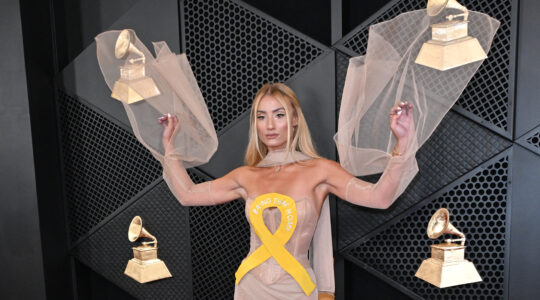NEW YORK, Oct. 5 (JTA) As if to underscore what some Jews believe is a media bias against Israel when portraying violence in the Middle East, The New York Times and other major dailies this week misidentified a Jewish victim as a Palestinian in one of their photos illustrating the bloodshed in Israel.
The photo, actually shot and labeled by The Associated Press, was displayed prominently in the Sept. 30 edition of the Times on page A5.
On Wednesday, The Times and other major dailies that had run the photograph ran a correction.
In the foreground of the photo was a profile of a young man with Semitic features, blood streaked across his face and spattered on his shirt. In the background was a menacing-looking Israeli policeman, waving a baton.
The caption stated simply, “An Israeli policeman and a Palestinian on the Temple Mount.”
Given the context of the violent clashes between Israeli and Palestinians this week, the implication of what seemed to have happened was clear.
In fact, the victim was Tuvia Grossman of Chicago, an American studying in Israel. It was his father, Dr. Aaron Grossman, who was quick to notify the Times.
In a letter to the paper, the elder Grossman explained that his son “and two of his friends were pulled from their taxicab while traveling in Jerusalem by a mob of Palestinian Arabs and were severely beaten and stabbed.”
The policeman photographed was in fact trying to protect Tuvia, said his father.
Moreover, the scene occurred elsewhere in Jerusalem’s Old City, not on the Temple Mount.
Tuvia Grossman was released from a hospital Wednesday, but returned there after fainting Thursday, according to the Israeli Consulate in New York.
The letter written by Grossman’s father and a second one penned by his brother circulated widely on e-mail lists, apparently prompting pressure on various newspapers to print corrections.
On Thursday, Yeshiva University’s College Student Council held “a day of prayer” to protest what it called the “gross distortion by the media” and ensure that “Tuvia Grossman shall not go down in history as a Palestinian victim of Jewish aggression.”
Some Jewish groups have long complained about the mainstream media’s tendency to portray bloody clashes simplistically as heavily armed Israeli officers reacting aggressively to stone-throwing Palestinian youths.
Andrea Levin, executive director of the Boston-based Committee for Accuracy in Middle East Reporting in America, said she understands “there are honest mistakes” made “in the heat of the moment.”
However, that so many newspaper editors seized on this photo and ran it large reflects “ingrained assumptions” about the nature of street clashes in Israel, Levin said, and “fulfilled the perception of what is happening there now that there is only one victim in this conflict, the Palestinian.
In its correction, the Times simply attributed the mistake to “erroneous identification.”
The Associated Press also sent out a correction to its media clients on Wednesday.
However, an AP spokeswoman told JTA that because “there have been people wanting to know and wanting the correction,” the news service took the unusual step of actually writing an article about the entire incident.
That article, the spokeswoman said on Thursday, had not yet been completed and will be sent out “when it’s perfect.”
Though it’s unclear what the thrust of the article will be, Levin took some credit for the AP’s unusual move.
“We’d been urging them to do a story on Tuvia’s experience,” she said.
“The photo depicted something that has not yet been reported, that there are cases of Jews who have been singled out and beaten or stoned.”
Nevertheless, said Levin, neither the AP article nor any correction in a paper will “come close to undoing the impact” the photo, which ran on Rosh Hashanah, has had.

Help ensure Jewish news remains accessible to all. Your donation to the Jewish Telegraphic Agency powers the trusted journalism that has connected Jewish communities worldwide for more than 100 years. With your help, JTA can continue to deliver vital news and insights. Donate today.





